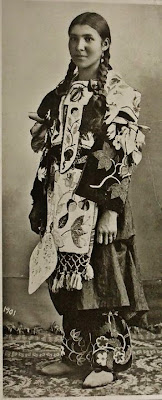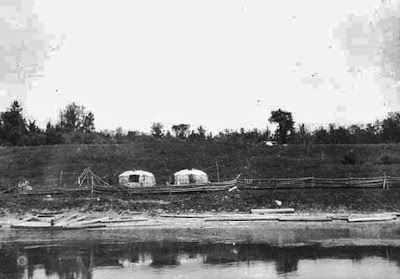About American Indiana Symbols and Picture Writing.
The Indians did not know how to write words by means of letters. There were, however, many things which they wished to remember, and they had found out several ways in which to record these.
Thus among the Sacs and Foxes there is a long legend with songs telling about their great teacher, the good, wise, and kind Wisuka. It is difficult to remember exactly such long narratives, but with objects to remind the reciter of each part, it is not so hard. So the persons who are to repeat the legend have a micäm. This is a wooden box, usually kept carefully wrapped up in a piece of buckskin and tied with a leathern thong; in it are a variety of curious objects, each one of which reminds the singer or reciter of one part of the narrative. Thus he is sure not to leave out any part. In the same way mystery men among other Algonkin tribes have pieces of birch bark upon which they scratch rude pictures, each of which reminds them of the first words of the different verses in their songs. Such reminders are great helps to the memory. Among the Iroquois and some eastern Algonkins, they used, as we shall see, wampum belts to help remember the details of treaties or of important events.


Among many tribes pictures were used for recording matters of importance. Many Sioux chiefs have written the story of their life in pictures. They took several large sheets of paper and gummed the edges together so as to make one long strip. Upon this they made pictures representing the important incidents in their lives. Thus in one picture was shown where, as a boy, the artist shot his first deer; in another was represented his first hunting party; in another, how he went on the war-path to gain the name of brave; in another, where he danced the sun dance; again, how he went to Washington to see the white men's officers, on business.
The most important record made by the Sioux is the Dakota Calendar. More than a century ago a Sioux Indian determined to keep a count of the years and of their happenings. So he began a record which was called a “winter count,” where the events of the different years were shown by pictures. His idea became popular, and a number of these winter counts were begun by other Indians. The most important of these is one which has been called the Dakota Calendar. It belonged for a long time to an Indian named Lone Dog. The one he had was a copy on cloth from a still older one, which had been made upon a buffalo skin. This count appears to have begun about the year 1800.
The Dakota Calendar. (After Mallery.)
Each year its maker selected some important event, by which the year was to be remembered, and made a picture for it. The first five or six pictures run in a nearly straight line to the left; the line of pictures then coils around and around this, the last picture always being added to the end of the coiled line. The pictures are in black and red, and while rudely drawn, most of them can be easily recognized. In 1801 the Sioux had a terrible attack of smallpox, and many of them died; the picture for the year is a man covered with red spots. Whooping-cough is a disease of which white people have little fear, but it is sometimes very destructive to Indians; in 1813 it was among the Sioux, and the picture for that year was a man coughing, as shown by lines diverging from in front of his mouth. In 1840 the Sioux made a treaty of peace with the Cheyennes; the picture shows two hands extended for a friendly grasp. In 1869 there was a total eclipse of the sun, which is represented by a blackened sun and two stars in red: “The stars were seen in the daytime.” In 1833 was the famous display of meteors or falling stars, which was witnessed in all parts of the United States, causing great excitement; many white people believed that it portended the destruction of the world. This star shower was noticed by the Sioux keeper of the winter count, and is represented by a black moon and a lot of red stars represented as falling. You can pick out these different figures in the picture, which represents Lone Dog's winter count, or the Dakota Calendar as it would look on a buffalo hide.
Indian Letter on Birch Bark. (From Schoolcraft.)
Probably you have all seen pictures of a birch-bark letter written many years ago by an Ojibwa Indian. It was written by one of Schoolcraft's guides. Mr. Schoolcraft, with a party of assistants and soldiers, was on a journey of exploration in the Northwest. One morning as they were leaving camp, Schoolcraft saw an Indian putting a bit of birch bark, upon which he had drawn some pictures in black, into a cleft at the end of a pole. This pole was then stuck slantingly into the ground and three notches were cut in it. When Mr. Schoolcraft asked his guide for an explanation, he said this letter would inform any Ojibwa Indians who might pass, about their party. The eagle in the upper corner showed that they were from Washington—government people. The other pictures showed that there were eight common soldiers each with a gun; that there were six officers, the duty of each being indicated by something carried in the hand,—the captain by his sword, the secretary by his book, the geologist by his hammer, etc.; that soldiers and officers were white men, as shown by their wearing hats; that there were two guides, Indians, as shown by their having no hats and carrying spears; that the night before there were three fires in the camp, soldiers, officers, and guides, camping separately; that during the day there had been secured a prairie hen and a turtle, both of which had been taken by the officers for supper. But other facts were shown besides those told in the pictures. The pole stuck into the ground pointed the direction in which the party would journey; the three notches on the pole told that they would journey in that direction three days.
Of all American Indians those who went farthest in the direction of developing writing were some of those living in Mexico and Central America. The Aztecs had an extensive system of picture writing. By means of pictures they recorded their traditional history and gave full directions regarding the worship of the gods. They had real books written with these pictures. These books were written sometimes on skin, sometimes on paper. The Aztecs made two kinds of paper, one of the soft inner bark of a tree, the other from the maguey plant. The latter sort was beaten out of the mass of leaf fibres after they had been soaked in water. The maguey plant is much like the century plant which you have seen in parks and greenhouses. The paper or dressed skin was made into long narrow strips many feet in length. These strips were folded back and forth like a screen, and the ends were fastened to two thin boards which served as covers for the book. Sometimes bits of polished green stone were inlaid into these covers to make them pretty. Some of these old books are still in existence, though most of them have long been destroyed. We cannot read any of them very well because pictures are uncertain means of conveying information. Still we can tell something about their meaning.
Page of Aztec Book. (From Photograph.)
Charles V, to know about them, and ordered three skilled painters of the Aztecs to prepare a book to be sent to the Emperor. Each artist took a different subject, so the book ]consists of three parts. The first gives a picture-written story of the Aztecs from the time when they began their wanderings; the second gives a list of the towns that paid tribute to the city of Mexico and a statement of the kind and amount of tribute each paid; the third shows how children were trained, how they were punished when they were naughty, and what kind of work they were taught. Of course the Emperor would not understand the meaning of all these queer pictures, far different from anything he had ever seen; so Mendoza had an explanation or translation written with all the pictures. This is as fortunate for us as it was for the Emperor: in this way we can learn something about the use and meaning of these characters.





































